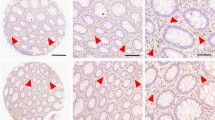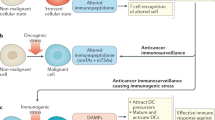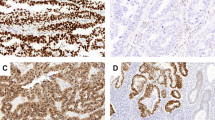Abstract
This study aimed to investigate whether immunohistochemical staining for nm23-H1 protein in the primary tumour is correlated with tumour stage, tumour differentiation, DNA ploidy, cell proliferative index, p53 status and patient survival time in colorectal cancer. Full-cross colorectal cancer biopsies were collected from 202 consecutive surgical specimens between 1987 and 1990. Immunohistochemical expression of nm23-H1 protein was investigated in cryosections, using a monoclonal anti-nm23-H1 antibody (clone NM 301). The staining pattern was classified as follows: strong homogeneous intensity, moderate homogeneous intensity, moderate focal intensity, or as negative. Immunohistochemical expression of p53 was investigated using a monoclonal anti-p53 antibody (DO-7). The DNA ploidy and cell proliferative index were determined by flow cytometry. Possible correlation between nm23-H1 staining patterns and the other studied tumour characteristics was explored at the end of 1994. Median survival time of living patients was 66 months, range 50-93 months. No correlation was found between various nm23-H1 staining patterns and tumour stage, cell proliferative index or p53 status. Nm23-H1-negative tumours and tumours with moderate focal staining intensity were less differentiated than tumours with strong homogeneous or moderate homogeneous staining intensity (P < 0.05). Of the nm23-H1-negative tumours, a significantly higher number was near-diploid rather than aneuploid, as compared with those expressing positive nm23-H1 (P < 0.05). The number of dead patients in Dukes' stages B and C did not correlate significantly with the nm23-H1 staining pattern. The nm23-H1 staining pattern alone, or combined with either of the other explored tumour characteristics, did not correlate with patient survival time. Immunohistochemical studies of the nm23-H1 protein expression are of minor value in the staging and prognostic prediction of colorectal cancer.
This is a preview of subscription content, access via your institution
Access options
Subscribe to this journal
Receive 24 print issues and online access
$259.00 per year
only $10.79 per issue
Buy this article
- Purchase on SpringerLink
- Instant access to full article PDF
Prices may be subject to local taxes which are calculated during checkout
Similar content being viewed by others
Author information
Authors and Affiliations
Rights and permissions
About this article
Cite this article
Lindmark, G. NM-23 H1 immunohistochemistry is not useful as predictor of metastatic potential of colorectal cancer. Br J Cancer 74, 1413–1418 (1996). https://doi.org/10.1038/bjc.1996.557
Issue date:
DOI: https://doi.org/10.1038/bjc.1996.557
This article is cited by
-
The role of NM23 in patients with colorectal cancer: A systematic review and meta-analysis
Journal of Huazhong University of Science and Technology [Medical Sciences] (2017)
-
Searching for consistently reported up- and down-regulated biomarkers in colorectal cancer: a systematic review of proteomic studies
Molecular Biology Reports (2012)
-
The intratumoral microvessel density and expression of bFGF and nm23-Hl in colorectal cancer
Pathology & Oncology Research (2006)
-
Gene expression profiling of colon cancer by DNA microarrays and correlation with histoclinical parameters
Oncogene (2004)
-
The nm23-H1 gene as a predictor of sensitivity to chemotherapeutic agents in oesophageal squamous cell carcinoma
British Journal of Cancer (1999)



